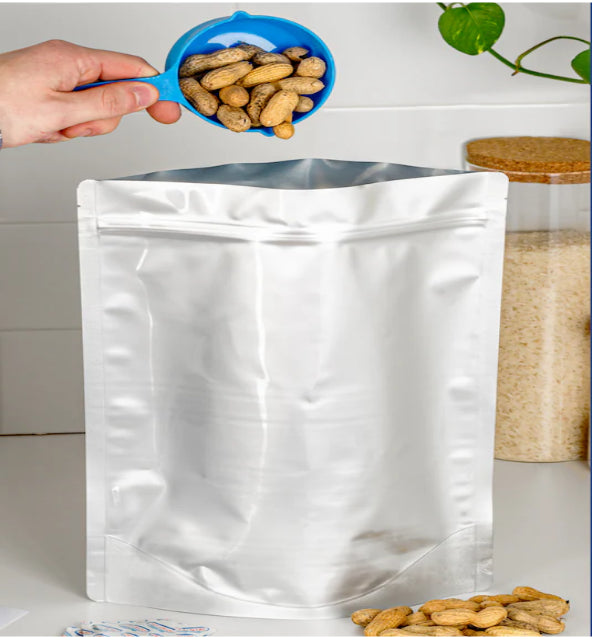When you start building a food storage plan, one question always arises: Mylar bags vs. vacuum sealing - which should I choose?
Both methods work, but they work in very different ways. One is designed for true long-term preservation. The other is designed for short-term or freezer use, where space is more important than years of protection.
The difference comes down to what you are storing and how long you expect it to last. Take a look at our thorough comparison.
How Mylar Bags Work

Step into the pantry of a serious prepper and you’ll see rows of silver bags stacked neatly. Those are Mylar bags, and they do more than look sturdy.
Each layer of the film shuts out oxygen, moisture, and light. That combination creates a controlled environment where food keeps its flavor and nutrition steady.
Add oxygen absorbers, and you’re not just extending life by a few months; you’re extending it by decades.
Now you wonder, how is Mylar the better option?
Do you want 30 years of spoil-free storage for rice, beans, oats, or flour, or would you settle for the short window vacuum sealing provides? For anyone who wants food security, that answer is obvious.
Once opened, you can reseal a bag with heat and use it again. That’s why households, preppers, and small businesses keep turning to Wallaby Mylar bags. They aren’t just packaging. They’re long-term protection you can count on.
How Vacuum Sealing Works

Picture a kitchen counter with a vacuum sealing machine humming away.
You slide in a cut of meat, press a button, and the air is pulled out until the bag clings tight to the food. That’s vacuum sealing: removing air around the product to slow down spoilage.
By cutting oxygen exposure, you hold back bacteria and mold, keeping food fresher for a limited period.
Vacuum sealing shines when you use the freezer. Meat, vegetables, or cannabis edibles stay compact and protected, saving space while avoiding freezer burn. If you buy in bulk or portion meals for the week, this method keeps everything tidy and ready to grab.
Still, it’s worth asking: do you need food safe for the next couple of months, or do you need food secure for the next couple of decades?
Vacuum sealing is useful for convenience and short-term storage, but it isn’t designed for longevity. Most bags are single-use, and they let in light over time. For everyday kitchen use, vacuum sealing works. For true preservation, it stops short.
Mylar Bags vs Vacuum Sealing | A Quick Comparison
Here’s where the two options meet side by side. The table shows how they stack up, making it easier to choose what fits your needs.
| Feature | Mylar Bags | Vacuum Seal Bags |
| Best for | Long-term dried goods |
Short to medium-term frozen goods |
| Protection | Blocks light, oxygen, and odors |
Removes most air but not all light |
| Reusability | Resealable with heat |
Limited reuse, usually single-use |
| Shelf Life | Up to 30 years (with oxygen absorbers) |
1 to 3 years depending on storage |
| Ideal Use Cases | Rice, beans,flour, grains |
Meat, veggies, edibles, leftovers |
| Space Efficiency | Moderate | Very compact |
So, which matters more to you? If you value decades of stability, Mylar is the path forward.
If you care more about freezer space and weekly convenience, vacuum sealing makes sense. Many households use both, but knowing the difference keeps you in control.
When To Choose Mylar Bags

Mylar bags are the right call when you want true longevity. Dried goods such as rice, beans, oats, and flour can last up to 30 years when packed correctly with oxygen absorbers. That’s food security that most other storage methods cannot match. If your goal is to build a reserve you can trust, Mylar is where you start.
Now ask yourself: do I want to rotate food every year, or do I want to seal it once and forget it for decades?
That’s the decision Mylar helps with. It’s why preppers line their shelves with silver pouches and why families investing in long-term planning choose them over quick fixes.
Reusable seals make Mylar practical as well. Open a bag, reseal it with heat, and continue using it. With Wallaby Mylar bags, durability is built in, and oxygen absorbers come ready to extend shelf life further.
When To Choose Vacuum Sealing
Vacuum sealing fits when you need space efficiency and short-term freshness. Think about freezers packed with meat, vegetables, or homemade edibles.
Each vacuum-sealed bag lies flat, occupying minimal space and remaining organized. If you shop in bulk or want weekly portions ready to go, this method saves time and reduces waste.
Now consider your storage goals.
Do you want compact freezer packages that keep food fresh for one to two years? Then vacuum sealing earns its place. It helps avoid freezer burn, keeps flavors intact, and makes grabbing meals easier.
The tradeoff is clear: vacuum sealing does not promise decades. Most bags are single-use, and they do not block light completely.
For families or businesses that want to move food quickly and manage storage neatly, vacuum sealing works. But if your plan stretches into years, you already know where it falls short.
Safe Storage With Wallaby Mylar Bags
For lasting peace of mind, Wallaby Mylar bags give you an edge that vacuum sealing can’t. Our layered design blocks light, moisture, and air, creating conditions where dried foods stay protected for decades.
Pair them with Wallaby oxygen absorbers, and you lock in freshness, flavor, and quality long after ordinary packaging has failed.
Vacuum sealing remains useful for short-term convenience, but it was never built for generational storage.
When you want a reserve that lasts, Wallaby provides the security you can rely on. Safe storage starts here.
SHARE:





